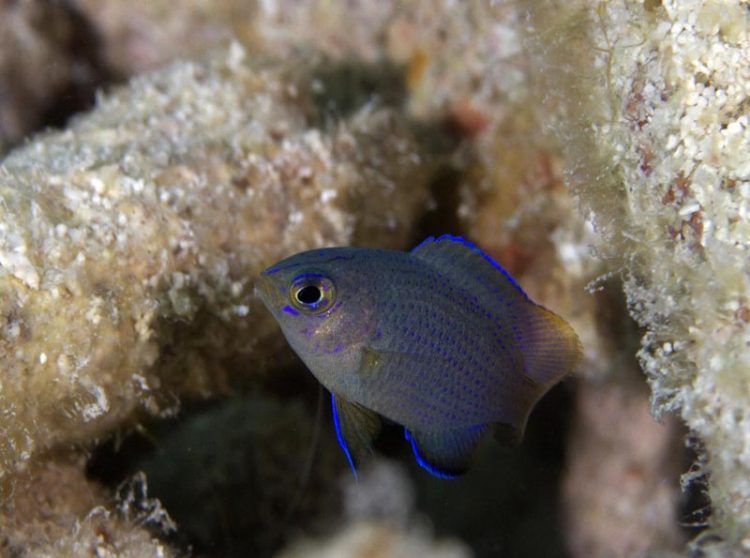New study showed spawning frequency regulates species population networks on coral reefs

This is a juvenile bicolor damselfish (Stegastes partitus). Credit: Evan D'Alessandro, Ph.D.
New research on tropical coral reef ecosystems showed that releasing larvae more often is beneficial for a species' network. The study on reproductive strategies is critical to assess the conservation of coral reef ecosystems worldwide.
Researchers from the University of Miami (UM) Rosenstiel School of Marine and Atmospheric Science used a computer model developed by UM Rosenstiel School scientist Claire Paris, known as the Connectivity Modeling System to track larval movements of three distinct reef species – the Carribean sea plume (Anthiellogorgia elisebeathae), the bicolor damselfish (Stegastes partitus) and the Caribbean spiny lobster (Panulirus argus). The three species, which have varying larval dispersal strategies, were simulated in a dynamic natural marine system over time to determine whether dispersal was driven by environmental or biological factors for the modeled species.
Many coral reef species live on separate habitat patches on coral reefs that are linked through larval dispersal into a larger population network. As a parent population spawns, the eggs and larvae are transported in the currents from their native location to another, more distant location. This exchange of larvae by currents between geographically separated populations create a network of connections, which is known as a connectivity network. The authors suggest that the more often an animal reproduces, the greater the variability in the ocean currents that larvae can experience, and the more potential habitats that a dispersing animal could be connected to.
“We found that the rate at which a species spawn drives the relatedness between distant populations,” said Claire Paris, associate professor of ocean sciences at the UM Rosenstiel School. “Therefore more frequent spawning is more likely to stabilize the connectivity network.”
“There is tremendous variability in how often reef animals reproduce and release eggs and larvae, yet they all find their way to coral reefs,” said Andrew Kough, UM Rosenstiel School alumnus and lead author of the study. “Our study explored how changes in reproductive frequency shape an animal's connectivity network.”
The researchers also found that larval behavior enhances the persistence of these network connections, when compared to passive transport by the ocean currents.
“For animals that reproduce infrequently, vertical swimming behavior during the larval stage helps control the dispersal network and is a vital part of marine ecology,” said Kough.
The larval phase of a marine species is often the only time that coral reef inhabitants travel between habitat locations, an important early life history stage required to maintain healthy populations when environmental conditions fluctuate due to both natural and man-made factors.
“Our model has proved accurate enough to test important hypotheses in marine ecology, said Paris. “One hot topic has always been about the role of reproduction strategies on the structure of marine populations. We find a fine balance between spawning frequency and larval behavior in reef species.”
###
The study, titled “The influence of spawning periodicity on population connectivity,” was published in the Online First section of the journal Coral Reefs. The co-authors are Andrew S. Kough and Claire B. Paris.
About the University of Miami's Rosenstiel School
The University of Miami is one of the largest private research institutions in the southeastern United States. The University's mission is to provide quality education, attract and retain outstanding students, support the faculty and their research, and build an endowment for University initiatives. Founded in the 1940's, the Rosenstiel School of Marine & Atmospheric Science has grown into one of the world's premier marine and atmospheric research institutions. Offering dynamic interdisciplinary academics, the Rosenstiel School is dedicated to helping communities to better understand the planet, participating in the establishment of environmental policies, and aiding in the improvement of society and quality of life. For more information, visit: http://www.
Media Contact
All latest news from the category: Life Sciences and Chemistry
Articles and reports from the Life Sciences and chemistry area deal with applied and basic research into modern biology, chemistry and human medicine.
Valuable information can be found on a range of life sciences fields including bacteriology, biochemistry, bionics, bioinformatics, biophysics, biotechnology, genetics, geobotany, human biology, marine biology, microbiology, molecular biology, cellular biology, zoology, bioinorganic chemistry, microchemistry and environmental chemistry.
Newest articles

Superradiant atoms could push the boundaries of how precisely time can be measured
Superradiant atoms can help us measure time more precisely than ever. In a new study, researchers from the University of Copenhagen present a new method for measuring the time interval,…

Ion thermoelectric conversion devices for near room temperature
The electrode sheet of the thermoelectric device consists of ionic hydrogel, which is sandwiched between the electrodes to form, and the Prussian blue on the electrode undergoes a redox reaction…

Zap Energy achieves 37-million-degree temperatures in a compact device
New publication reports record electron temperatures for a small-scale, sheared-flow-stabilized Z-pinch fusion device. In the nine decades since humans first produced fusion reactions, only a few fusion technologies have demonstrated…





















